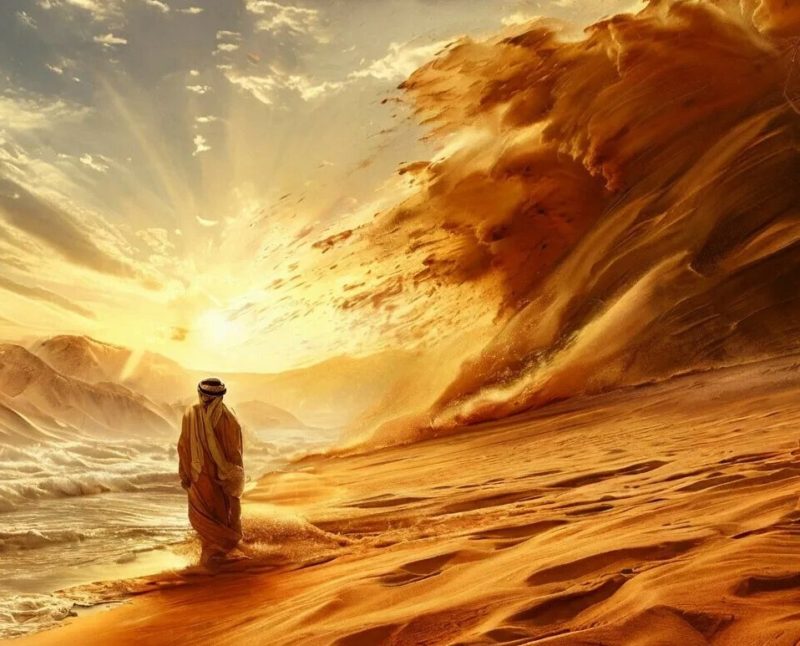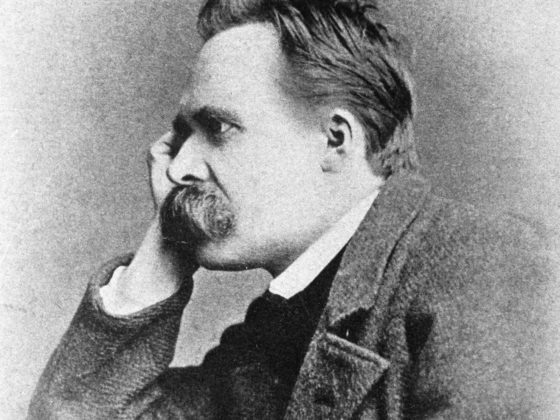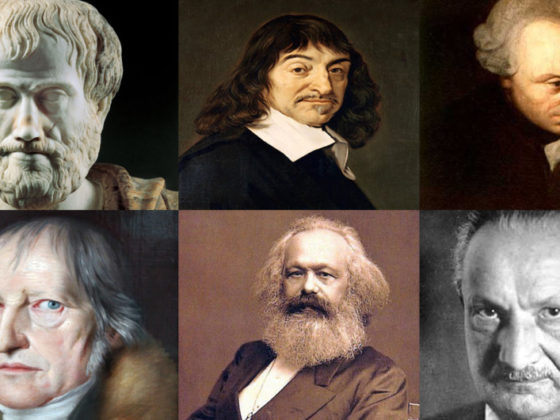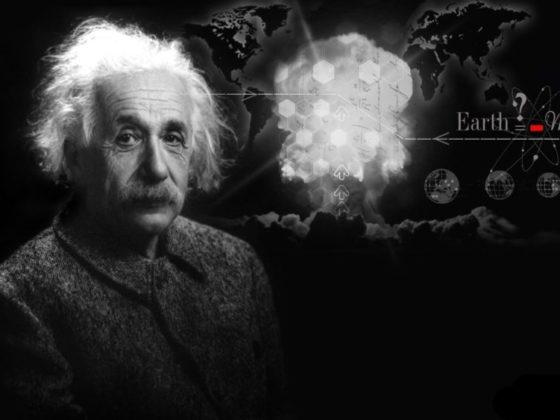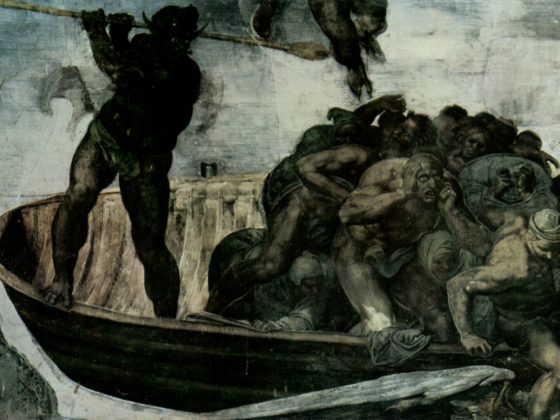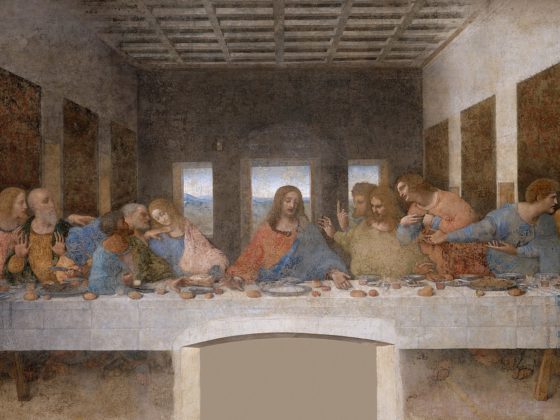It is narrated that Imam Reza (A) said, “There will be a grave and bloody turmoil in which all kinship and friendship will disappear; this is when the Shiʿa will lose a third of my descendants (that is, after the emergence of the last Imam). The inhabitants of the heavens and the earth—and every sad and oppressed person—will mourn for him.”
He then said, “May I be sacrificed for the one whose name will be the name of my grandfather (the Messenger of Allah), the one who will be like me and Musa ibn Imran (A)! Upon him is a cloud of light that shines with rays of holiness. How many believing men and women there will be, exhausted in search of spring water! I claim that I see them—despairing of his coming—when suddenly they hear voices such that for him there will be no difference between those far and near.”
The modern world is experiencing several crises, each of which would be sufficient to trigger a catastrophe on the scale of a global war. The first is environmental: the exponential destruction of nature. Humanity finds itself in a situation in which it will simply lack clean water and air. The second is the depletion of non-renewable resources such as oil and gas, which is already provoking a struggle for control over them. The third is the debt bubble that underpins the modern economy; when it bursts, the consequences could be such that people in previously prosperous countries may simply begin to die of hunger. The fourth is the collapse of morality—a universal moral crisis affecting family and values. The fifth is the degradation of nature’s integrity as a result of incursions at biological, genetic, and informational levels.
It appears that the world is living through the final years of the period that began after World War II. The Western world, having rejected the principles of order and constructed an artificial technological utopia, is headed toward total catastrophe as a result of overlapping crises.
What modern man calls “progress” is, in fact, the gradual degradation of his humanity. In the modern world, language is becoming simplistic, and high culture and complex thinking are disappearing. Most people today simply do not understand the cultural achievements of the past; their behavior has become elementary and driven by animal reflexes. For example, a German school leaver in late 1919 typically had functional knowledge of four languages and read classical authors in the original. Today’s German schoolchild—shaped by television series—speaks a hybrid of German and broken English and often struggles to answer questions on tests modeled on the American system.
Many elements of modern society resemble the primitive shamanism of the past: collective dances, the ecstasy of discos and concerts, mass sporting ceremonies. Rock and pop music are collections of rhythms and sounds that, like shamanic rituals, weaken logical faculties and conscious control. We see here the same process of dehumanization, a removal of the human veil, as in the occult civilizations of the past.
Mental degradation is accompanied by physical degradation. In so-called developed countries, about half of young men suffer from various forms of sexual dysfunction. By the age of twenty, many people already suffer from a host of ailments, from allergies and obesity to endocrine disorders, arthritis, and cancer. The modern pharmaceutical industry pumps them full of medications that, on the one hand, prolong life but, on the other, lead to new illnesses. Consequently, such a person’s existence becomes one of slow decline, prolonged for decades until death. One of the deceptions of the modern propaganda machine is the myth that people once typically lived only to the age of thirty, whereas, thanks to scientific advances, the average lifespan is now sixty or seventy. It is unclear where these inflated figures about an average lifespan of thirty come from. If we consult surviving accounts of notable figures from antiquity, we see that many lived to advanced ages: Pericles to sixty-eight, the playwright Sophocles to ninety, the philosopher Xenophanes to ninety-two, Pythagoras to around eighty, Plato to eighty-one, Archimedes to around seventy-five, and Socrates to seventy before dying by poison. Such ages were not exceptional. Consider also well-documented periods such as the early days of Islam: many Arabs of that era lived to old age; those who did not fall in numerous wars seldom died of disease, often living to eighty or ninety. Some companions fought into advanced age—for example, Muslim ibn Awsaj, around ninety at Karbala, fought and killed several enemies before being slain. Ammar ibn Yasir died at the Battle of Siffin at the age of eighty-seven, sword in hand. In pre-revolutionary Russian villages, sixty was not considered old, and centenarians were common. Thus, simplistic appeals to low ancient life expectancy are misleading; while there were exceptional periods of early mortality—such as plague years—these were exceptions, not the rule.
The rejection of a natural, organic way of life has led to the degeneration of modern man’s very appearance. Strength, masculinity, pride—these qualities have vanished from the faces of many city dwellers, replaced by a “third sex”: half-sagging jeans, androgynous hairstyles, and a loss of secondary sexual characteristics. The physical always expresses the spiritual; they are inseparable. If a person is degenerate, the degeneration will be written on his face. Women are not faring well either. According to some medical research, testosterone levels in modern women are rising; they are becoming more masculine, perceived as less attractive and less feminine by traditional standards. Some studies report a growing number of husbands being abused by their wives in Russia and in Western countries; men are turning to support organizations, and centers have been established to address these complaints. Instead of God’s model of humanity—stretched between two poles, male and female, offering a wealth of potential—we are seeing the emergence of a hermaphroditic “third gender” in full force.
People who look for simple explanations try to reduce all this to a “global conspiracy”—the machinations of a “global elite,” “Freemasonry,” the “Trilateral Commission,” and so on. In reality, there is no single conspiracy: the elites of the modern world essentially decide little, for they are themselves enslaved to technology like everyone else. Regardless of anyone’s wishes, the technological paradigm is slowly but surely killing the human species. Various pesticides and wastes from modern agriculture have contaminated groundwater hundreds of metres deep. Hormonal medications and drugs excreted in human waste enter the water supply and, without breaking down, reenter human bodies, disrupting hormonal balance, impairing male function, and causing cancer and infertility. The effects of gadgets and the countless artificial compounds synthesized by the modern chemical industry on the human body remain largely unstudied. The problem with some self-styled “intellectuals” is that they fail to distinguish cause from effect. It was not the modern elite that first caused technological degradation of humanity; rather, the dominance of technology created that elite. It is not homosexuality that caused the degeneration of modern man and the family; rather, the degeneration of man and family contributed to changes in sexual behavior.
This phenomenon resembles the resurgence of Buddhism today—both as a philosophy and a practice. The Dalai Lama is one of the West’s prominent figures. In many megacities, Christianity is being supplanted by Buddhist practices. This is not accidental. Aversion to fitrah—the natural disposition—is a common characteristic of both modernity and Buddhism. Both lean from being toward nothingness, hence their complementarity. Buddhism, in one sense, is a form of nihilism: according to the Buddha’s teaching, the world is continuous suffering, an illusion from which one must escape; all things are “condensed emptiness.” Enlightenment consists in recognizing emptiness and merging with it. If one realizes that existence is nothing but emptiness and dissolves oneself into it, one supposedly attains liberation—nirvana. Modern people are drawn to Buddhism because it aligns with the nihilistic emptiness that underlies their world.
Technological modernity was a vast experiment in creating an artificial civilization, opposed to life and fitrah. We live in a world of surrogates, where natural things are increasingly replaced by artificial ones. Humanity has enclosed itself within a technogenic circle from which it can no longer escape. Thus, what we face is not a single isolated crisis—an economic crisis or a cultural crisis as in previous eras—but a Crisis with a capital “C”: the crisis of humanity itself, the collapse of the being called “human.” The peak of its technological development has become the depth of its decline and degradation. Humanity has proven incapable of controlling its destiny; it has stretched out its hand to the tree of forbidden power and suffered the fall.
What prevents modern people from seeing the catastrophic nature of the situation is that, on the surface, material conditions appear to progress, while a vast media machine constantly proclaims that everything is improving, that new discoveries are being made, and that a bright future lies ahead. In reality, this monstrous propaganda industry distorts reality. We are shown a few isolated events—always in First World countries. A permanent “feast in time of plague” fills the airwaves with vulgar entertainment and systematic corruption. Meanwhile the collective suffering of humanity, which rarely appears on those screens, is greater than at any earlier time: half the world’s population suffers from hunger, and forty percent lack access to drinking water.
As we said, the Imam will appear when humanity completely despairs of solving its problems by itself. Illusions persist for now. Modern people are like morphine addicts: they began taking ever-larger doses of materialistic science and its technologies and felt “good” at first. But then they realize they are dependent—mere supplements to the drug—destroying themselves yet powerless to stop. So it is with modern humanity, which has entirely linked its fate to technology. There can be no turning back: now technology no longer serves people; people serve technology. A time will come when people will try to free themselves, but they will be unable to do so.
In truth, none of humanity’s problems can be solved by technological means alone. For example, advances in medicine led to a sharp decline in mortality, which disrupted the planet’s long-established demographic balance and caused explosive population growth, primarily in developing countries. This growth, in turn, increased famine, disease, epidemics, and death—exactly what “science” purported to fight. I am not saying medicine is bad or should not be used; rather, I assert that, on the whole, it has not achieved all the goals set for it.
Consider another area. For centuries people dreamed of automated machines performing all work for humans, leaving them to enjoy idle bliss. Modern science has come close to realizing that utopia. What happened? Automation displaced human labor; many lost the meagre incomes they once had and were cast into slums. By some estimates, slum dwellers now amount to as much as one-fifth of the world’s population, and their numbers keep growing. They are literally “superfluous people,” useful to no one—producing nothing and consuming little. They exist outside culture and civilization and beyond social bonds. These “cast-off” people, however, reappear as street gangs, robbers, criminals, mafias, and illegal migrants.
If these examples teach us anything, it is that humanity’s existing problems are not solvable solely by scientific and technological means. Experience shows that such interventions often exacerbate problems and prove counterproductive. A disease displaced from one area to another spreads in a more sinister form. The emergence of genetic engineering, mind-programming techniques, artificial intelligence, intelligent weapons, and many other terrifying developments suggests that science itself has become a source of danger—the central problem of our age—and demands urgent reckoning. Ultimately, the only realistic demand would be to halt the madness of unbridled science, which produces discoveries destroying our world. But such a halt is impossible: the genie is out of the bottle. Science and technology are now integral to modern societies and to rivalries between power centers that distrust each other—an autonomous terminator that cannot be stopped or even easily slowed. It has been reported that geneticists have bred square apples and peaches to ease transport. Why not next breed square people? Once such processes are set in motion, they will likely become irreversible.
It would therefore be a grave error to suppose—as some do—that the Imam will develop physical knowledge or modern technology. By the time he comes, such science will have discredited itself as a means of understanding the world; people will abandon it as they once abandoned magic. They will strive to rid themselves of science and the technology that is turning the earth into hell, but they will be powerless to do so. Humanity will suffer from global dehydration, pollution, terrible epidemics, mutations, and other calamities caused by technological civilization. Yet, like Frankenstein’s creation, humanity will be unable to escape its own work.
When the Imam appears, he will bring a wholly different, pure knowledge rooted in the secrets of the Qurʾan, and this knowledge will transform the world entirely. The earth will be filled from end to end with the sacred wisdom of the prophets, beside which modern science will appear childish. Nothing resembling modern technology will remain. People will be given capacities that will make today’s science seem laughably small.
If we look at Qurʾanic verses describing Sulaiman’s (Solomon’s) kingdom, we find them presented as a counterexample to the magical civilizations of that time. In Sulaiman’s dominion there were phenomena that appeared magical, but they were granted through monotheism and realized within a different paradigm. In the same way, the light of the Imam’s wisdom will close the gates of technological civilization. It will bring knowledge that constitutes a complete alternative to modern scientific and technological knowledge and, at the same time, open far greater possibilities.
We have said that the characteristic feature of the modern world is total nihilism: people no longer believe in anything, and all grand projects and ideologies have failed. For now they are being replaced by a vacuous ersatz—consumerism: “enjoy life; consume more.” But soon this simulacrum of meaning will cease to function, because humanity will enter an era in which further growth in prosperity will be impossible, even within first-world countries. The time of consumerism will end, and a scorched field of total darkness will emerge. The age of the old man—the Adamic age—will end. Humanity, united by globalism, will collectively descend into a black pool and drown. This will mark the bottom of the arc of descent.
From that total darkness will emerge the light of a new world, beneath which the banner of Divine guidance will be raised. “Qaʾim” is the principal epithet of the Imam; it appears in the hadiths of the Ahl al-Bayt even more often than “Mahdi.” The word qaʾim has many meanings: raising, rising, establishing, standing, realizing, existing, straightening.
One of the meanings of qaʾim is “standing.” Standing where? Standing between the qaws nuzul and the qaws suʿud—the arc of descent and the arc of ascent; between the Dunya and the Rajʿa. With his arrival the upward ascent begins after the downward descent. This explains why he will come precisely when the world reaches an extreme point of corruption.
Imam Sadiq says: “They will be purified in Rajʿa as gold is purified, so that everything will return to its truth.” Gold is purified by fire. Everything will be returned to its reality and truth, beyond which lie the endless worlds of Paradise and the endless worlds of Hell. The arc of descent mixed truth with falsehood, light with darkness, increasing until bottom was reached. Iblis boasts, “I will command them, and they will corrupt Allah’s creation.” The mirrors’ shapes change so that light ceases to be light and becomes darkness. Imagine a room of curved mirrors: people who enter see their images distorted. A person is not distorted because of himself but because the mirrors—shaped by the actions of created beings—distort the reflection. In other words, by exercising the freedom granted them, beings create the curved mirrors that distort their original image.
But after reaching rock bottom, creation begins to return to its foundation. This is the coming of the Imam. “Qaʾim” also means “straightener”—he who begins the straightening of things, the return of each thing to its foundation, to its natural primordial fitrah: “The fitrah of Allah in which He created mankind” (30:30). We say “begins” because there will then follow a very long period of Rajʿa during which this process continues and culminates in the Muhammadan kingdom, to be followed by the blowing of the trumpet and the general resurrection.
The hadiths that speak of the Qaʾim’s wars and vengeance refer to this correction—the straightening of human form. The Imam will not come for mere war or bloodshed; he is the all-encompassing mercy of Allah. He will come to fill the world with justice, fairness, light, and knowledge. Yet such straightening is impossible without resistance from the old and obsolete distortions that have long persisted. As gold is purified by fire, so everything will be tested. Allah created events to occur through cause and effect, not by a mere act of will.
Here I would like to stress an important point for understanding the present situation: the global spread of Shiʿism. There was a time when a small group of Shiʿa gathering for a mourning service for Imam Husayn (A) was regarded as a notable achievement. Today the banners of Shiʿism are raised worldwide; there is scarcely a city or village without Shiʿa. These banners will not be lowered. The point of no return has been passed.
One may seek political, demographic, or technological explanations—globalization and the internet have certainly helped spread Shiʿi teachings. That is secondary. What matters is the outcome: the world has entered the final phase of Adamic history; the prophetic argument must be fulfilled for all humanity.
At the same time, the Nasibi side seethes like never before. Wahhabis and Nasibis are also present across the world; they blow things up, kill people, and spread hatred, chaos, and bloodshed. A polarization is taking place on a global scale. The Nasibi current is bringing forth the figure known as Sufyani. The banners of the Qaʾim are rising, and the banners of Sufyani rise with them.
We have said that all faiths and ideologies are dead—except Shiʿism, that is, true Islam, and Nasibism, the anti-Islam of false faith. Thus the decaying Christian world gave birth to a technological civilization that encompassed the entire planet and united it. That globalized, declining world is now the arena of struggle between two banners: the banner of the Qaʾim and the banner of Iblis.
Ibn ʿAbbas narrated from the Messenger of Allah (S) on the meaning of the verses of Surah ash-Shams: “By the sun and its radiance”—this is the Prophet; “and by the moon when it follows it”—Ali ibn Abi Talib; “and by the day when it reveals it”—Hasan and Husayn; “and by the night when it covers it”—the Umayyads. Allah made me a prophet, and I came to the Umayyads and said, “I am a messenger to you.” They said, “You lie; you are not a messenger.” I came to the Hashemites; Ali believed in me, secretly and openly, and Abu Talib supported me openly and believed secretly. Allah sent Gabriel with His banner and placed him among the Hashemites; He sent Iblis with his banner and placed him among the Umayyads. They will remain our enemies, and their supporters will remain enemies of our followers until the Day of Judgment.
This return—the straightening of fitrah on the arc of ascent and the great return—will occur through the blood of Husayn (A). As I described in verse, describing the night of the Qaʾim’s birth:
That night a star lit up in Samarra,
whose brilliance eclipsed the moon’s radiance:
its height reached the Throne,
and its ray illuminated the darkness of Karbala,
where Muhammad’s descendants were taken captive,
and Husayn lay prostrate on the ground—
on that night, streams of scarlet blood
became a sword burning in the darkness.
The streams of sacred blood shed at Karbala became the sword of the Qaʾim, burning in the darkness of that era of creation when “lies have their time.” The hadith say that Allah filled all things with the blood of Husayn: “The earth and all that is upon it are filled with your blood, O son of the Messenger of Allah.” This blood provides the impetus for the return of creation upward, toward the infinite worlds of Paradise. In one of Husayn’s ziyārāts, Imam Sadiq (A) says, “I bear witness that you are the blood of Allah, and He will take your blood from all creation.” This is not simply a story of personal vengeance; the reality is deeper. Revenge for blood is the return of everything to its rightful place—the correction of the mirrors of creation.
As I continue in the same poem:
O avenger of blood! Awaits you, an infant,
whose cry has not ceased until now:
the voice of the arrow became his lullaby,
and Harmala’s bow his cup of water.
With a smile, he extended his palms to Husayn,
mistaking the arrow’s point for water,
and I do not know whether the arrow is in his throat,
or whether it has pierced your heart.
O he whose ancestors are the best of ancestors,
and whose mother is the best of mothers!
Two bloods await you—that between the door,
and that shed at Karbala.
I know you endure, though your sword is full of wrath,
boiling, ready to tear its scabbard—
once God’s plan reaches its limit,
and the time comes, you will emerge again,
among people from whose faces humility
flows like the glitter from their swords;
Their gaze is coal, their heart is iron,
their slogan is “for the blood of Husayn.”
Come! For the hearts of all creation are trembling with anticipation,
unable to restrain themselves,
and the banner spread over the universe,
and the fiery sword illuminating the night.
Once, Caliph Harun al-Rashid—the Pharaoh of his time—ordered the seventh Imam, Musa ibn Jaʿfar al-Kadhim (A), to be brought and asked, “Who owns this world?” The Imam replied, “He is the cause of weakness for our Shiʿa and fitna for those outside them.”
Harun asked, “Why does the owner of this world not take it back?”
Consider the Imam’s answer: “It was taken from him prosperous, and it will not return to him except prosperous.”
From Adam onward, whom Allah appointed as Caliph, this world was meant to be prosperous. The world ruled by the Wali—the Vicegerent of Allah—is a prosperous world. Oppressors have corrupted it. This world has been ruined and filled to the brim with lies and evil. But the time will come when it will be returned to the hands of its Master, prosperous and cultivated.
Therefore the reason for the concealment of the Imam of our time is both hidden and straightforward. The secret of concealment is this: Allah has a program. For this program to be fulfilled, the Imam must be concealed so that he can completely change the earth and alter the universe. That change must be prepared. The transformation of the universe, and thus the fulfillment of the divine program, cannot happen without a very long period during which His vicegerent remains concealed.
The world must reach a condition where it possesses qabiliyat—the receptive capacity—to perceive and understand his words and secrets. Just as a child in the mother’s womb must have its organs fully formed to live after birth, so the world must be prepared; otherwise it cannot receive the Imam. Numerous hadiths indicate that the world must fall into disrepair before the Imam emerges from concealment; it must collapse and exhaust itself, and then he will come and rebuild it anew.
How are these two perspectives reconciled? On the one hand, the world must be ready for the Imam’s appearance; on the other, it must disintegrate externally. The correct reconciliation is this: the world must decay externally (zāhir) while maturing internally (bāṭin). The human program will collapse outwardly, while the program of divine guidance will ripen within it through a vicegerent. This is like a seed sown in the soil: it must decay and perish before it bears fruit.
Our world ascends, gradually reaching the level of barzakh from which it originally emerged with Adam. Once it attains this level, the Imam will appear before us in all his splendour. “It was taken from him prosperous and will not return to him except prosperous.”
Imam Sadiq (A) told some companions: “Hope for that in which you have despaired, more than that in which you have hope! For Musa ibn Imran (A) went to obtain fire for his family and returned to them as a prophet and messenger. Just as Allah arranged the affairs of Musa (A) in a single night, so will He do with the Qaʾim, the twelfth Imam: He will arrange his affairs in a single night, as He arranged the affairs of Musa (A), and will lead him out of confusion and concealment to the light of deliverance and victory.”
